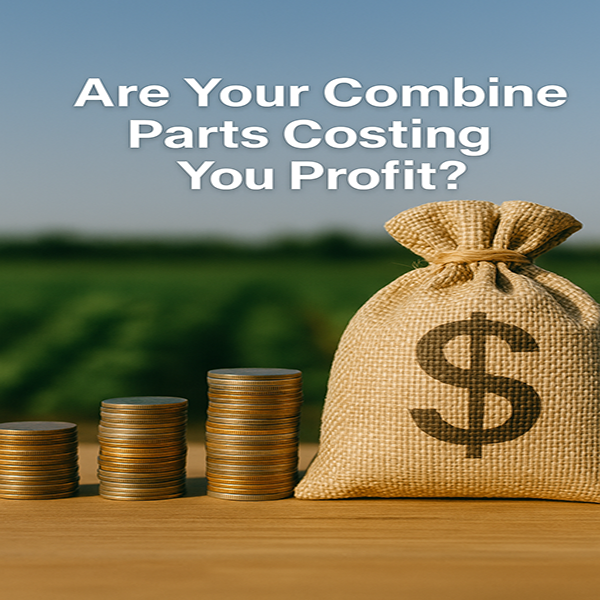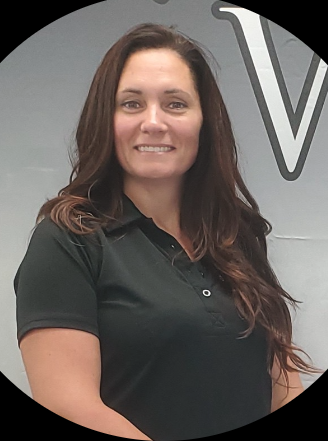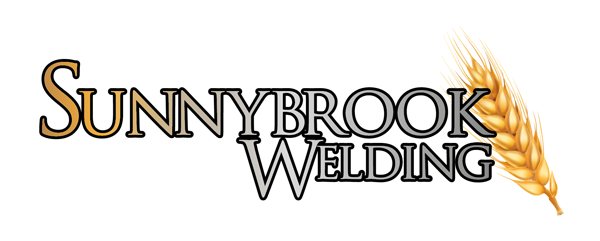SUNNYBROOK WELDING BLOG

Are Your Combine Parts Costing You Profit?
When you manage thousands of acres and run a farm like a business, because it is one, every decision affects your bottom line. Yet, too often, profit quietly leaks out of the grain tank due to something as simple and overlooked as worn, poorly performing combine parts.
In this post, we'll explore how your combine components directly impact yield, downtime, and profitability and how leading farm business owners are staying ahead with smarter upgrade decisions.
The Hidden Yield Loss: It's in Your Machine, Not the Field
Most farmers are laser-focused on inputs, weather, and crop rotation. But many overlook what happens after the crop is mature, during harvest. Inconsistent threshing, cracked grains, and losses out the back of the combine can cost you thousands of bushels.
The main culprits? Worn or poorly performing parts like concaves and cylinders.
Top Causes of Harvest Loss Due to Parts:
Slipping or worn rasp bars reducing threshing efficiency
Improper clearance or buildup in concaves causing grain damage
Uneven feeding or wear causing separation losses
Excessive rotor loss due to misfitting aftermarket parts
Downtime Costs You More Than Repairs
Harvest season is a critical period when every hour counts. Unexpected combine downtime not only incurs repair expenses but also leads to significant financial losses due to harvesting delays.?
A whitepaper by Parker Hannifin states, "The loss of a single day of combine use can cost thousands of dollars." This underscores the substantial impact that equipment downtime can have on farm profitability1.?Parker Furthermore, a study by the LSU AgCenter estimates the total combined harvest cost per acre at $39.49, including fixed and variable costs. Delays caused by equipment failure can increase these costs, especially when factoring in additional labour, fuel, and potential yield loss due to untimely harvesting2.?LSU AgCenter
Investing in preventative maintenance and timely equipment upgrades can mitigate these risks, ensuring that your operations run smoothly during the most crucial times of the year.
When equipment fails, mainly due to a part that should have been replaced, you're not just paying for repairs; you're losing grain and labour efficiency and often working in adverse weather conditions.
You know the feeling.... It's happened before... You're standing in the field, weather window closing fast, crew waiting, machines are idle... and all because a part gave out that shouldn't have. You think back to that moment in the shop when you noticed the wear and thought, "Meh, it'll probably get me through one more season," and pushed it aside. Now, it's not just a broken part; it's lost yield, delayed acres, extra costs, and a sinking sense that it all could've been avoided. It's costly downtime!! At Sunnybrook, we've been there too. That's precisely why we design parts that help you avoid that moment entirely. Because every hour matters, and every harvest counts.
Upgrading Is Not an Expense, It's a Profit Strategy
According to a report by McKinsey & Company, implementing predictive and preventative maintenance strategies can reduce machine downtime by 30% to 50% and extend equipment life by 20% to 40%. For large-scale farm operations, those gains translate directly into increased harvest efficiency, fewer delays, and stronger bottom-line performance3. McKinsey
For large operations managing 7,000+ acres and multiple machines that impact compounds quickly. You don't get a second chance at harvest. Upgrades aren't luxuries. They're insurance policies against avoidable loss.
OEM vs. Aftermarket: Why Your Combine Parts Might Be Working Against You
Not all aftermarket parts are created equal. Many OEM parts are designed for baseline performance across wide applications. Quite frankly, most OEM parts are built for one thing: the mass market. And in the ag industry, that means corn and beans. You need better alternatives if you are harvesting something outside that narrow focus. Not to mention, OEMs are generally designed for replacement, not longevity.
Let's be honest here... OEMs aren't just in the business of building equipment; they're also in the business of selling parts and lots of them. That means the parts are designed with a planned obsolescence. If you wear it out faster, you need to replace it more often. It is no secret that it is part of the OEM profit model. Durability is not the priority, repeat purchases are.
However, at Sunnybrook, we take a different approach. We are not trying to lock you into a parts cycle; instead, we are trying to help you break it. You might ask, "Why would you do that? You, too, are a parts company trying to make money by selling parts." You are right about being a parts company, but I prefer to think of us as a solutions company. We provide solutions to farmers, not some band-aid temporary fixes. Sunnybrook was founded by farmers and has been farmer-owned for 46 years, so we view our business model through a very different lens.
We don't build in failure; we build for the long haul. Because the only thing worse than downtime is knowing it could have been avoided!
How Top Farm Business Owners Make Equipment Decisions
- Large-scale operators don't wait for things to break. They:
- Track ROI: Cost per bushel harvested, not just sticker price.
- Look Long-Term: Evaluate parts based on durability and performance under pressure.
- Work with Trusted Partners: Suppliers who understand farming, not just sales.
When evaluating a supplier, ag business owners prioritize:
- Reputation for reliability
- Responsiveness and expertise
- Proven field performance
Self-Assessment: Is It Time to Upgrade?
Ask yourself:
- Are you seeing higher grain loss than last year?
- Are your concaves or cylinders older than 2 seasons?
- Does your machine tend to plug up when you take in higher crop volumes?
- Did you experience any breakdowns last harvest?
- Have you changed crops or operating speeds without matching your parts?
- If you said yes to any of these, it's time to review your equipment strategy.
Did You Know?
Most of Sunnybrook's concaves are designed with longevity in mind. Most of our concaves have some economical refurbishment built right into the design. Our inserts are reversible. Our conventional concaves have replaceable wear edges. We do it this way so farmers know we build quality, long-lasting parts, which translates into return customers because of a name you can count on!
Pro Tip from the Field
"I have been running Sunnybrook cylinders for nearly 20 years. You can run your cylinder much slower, especially in canola. It makes a combine out of the machine. In tough conditions, you do not plug and nearly no maintenance."
- Paul Waldner
Three Quick-Fix Tips to Protect Profit This Harvest
- Inspect Before You Roll: Check wear patterns on concaves and rotor and cylinder bars and replace (or, in Sunnybrook's case, reverse if they haven't already been)
- Stock Critical Spares: Keep backup parts on hand to minimize downtime. Better to be looking at it than looking for it!
- Harvest Smart - Use of a Sunnybrook All-crop concave can save you critical time (and we all know time is money) when you have to switch from crop to crop
Ready to Harvest More Profit?
At Sunnybrook Combine Parts, we build parts that perform, because we know farming isn't a 9-to-5. It's a business built on precision, grit, and efficiency.
Let's talk about how our cylinders and concaves can improve your yield and bottom line this season.
Contact Us Today to upgrade your combine and put the profit back in your pockets!
References
¹ Parker Hannifin. The Top Challenges, Trends and Opportunities for Combine OEMs.
https://www.parker.com/content/dam/Parker-com/Literature/Hydraulics-Group-US/WhitePaper_The-Top-Challenges--Trends-and-Opportunities-for-Combine-OEMs.pdf
² Guidry, K. M. (2010). Rice Combine Harvest Costs in Louisiana. LSU AgCenter.
https://www.lsuagcenter.com/~/media/system/6/e/9/5/6e954acaa236ff1972ecd65dd960ad16/ricecombineharvestcoststaffreport201008.pdf
³ The Power of Preventive and Predictive Maintenance, McKinsey & Company via Automation.com, July 2023.
https://www.automation.com/en-us/articles/july-2023/power-preventive-predictive-maintenance

